Blockchain Technology: Security and Risk Management
VerifiedAdded on 2023/01/11
|11
|3368
|50
AI Summary
This report provides insights into blockchain technology, its working, security aspects, and hashing techniques. It explores the applications and capabilities of blockchain and discusses its future in the banking industry.
Contribute Materials
Your contribution can guide someone’s learning journey. Share your
documents today.
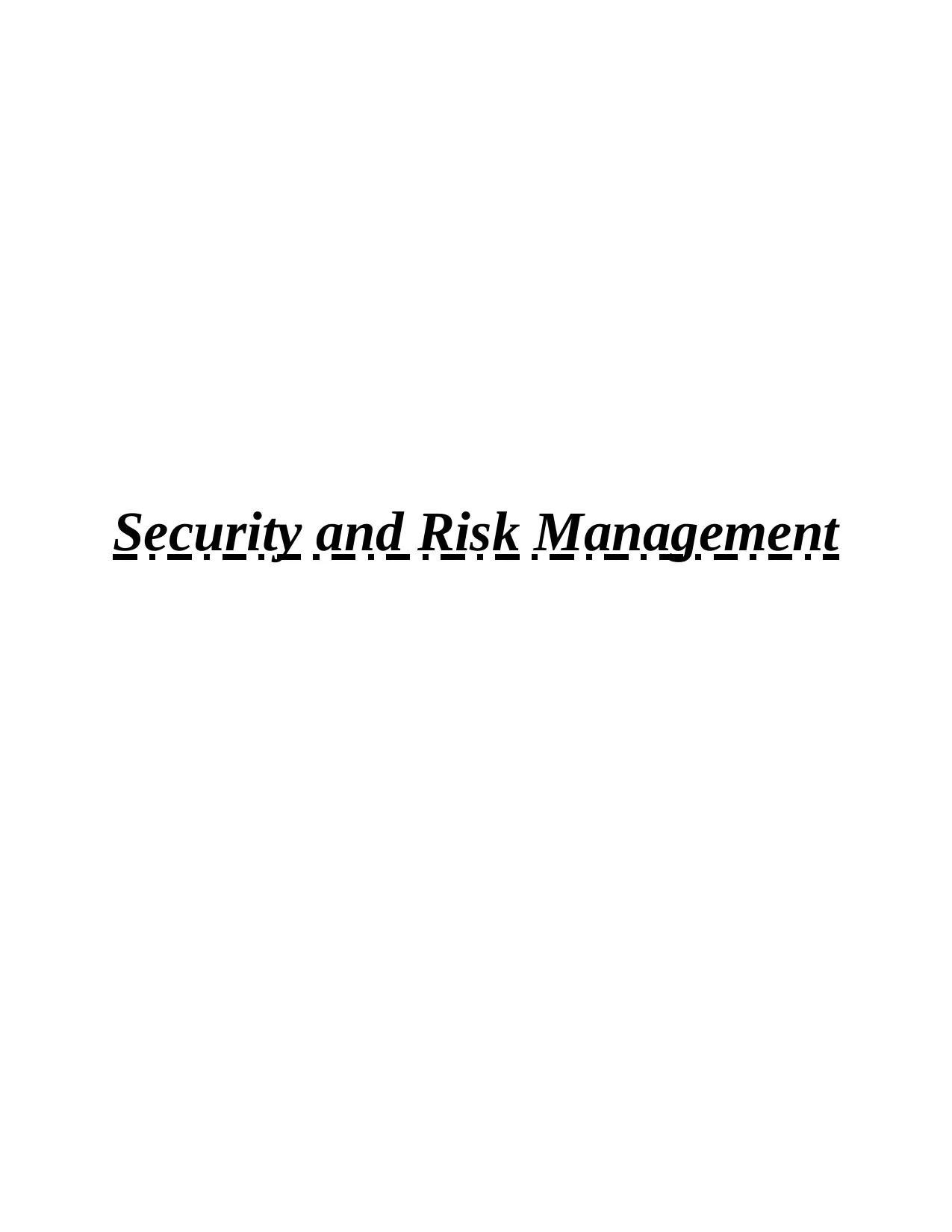
Security and Risk Management
Secure Best Marks with AI Grader
Need help grading? Try our AI Grader for instant feedback on your assignments.
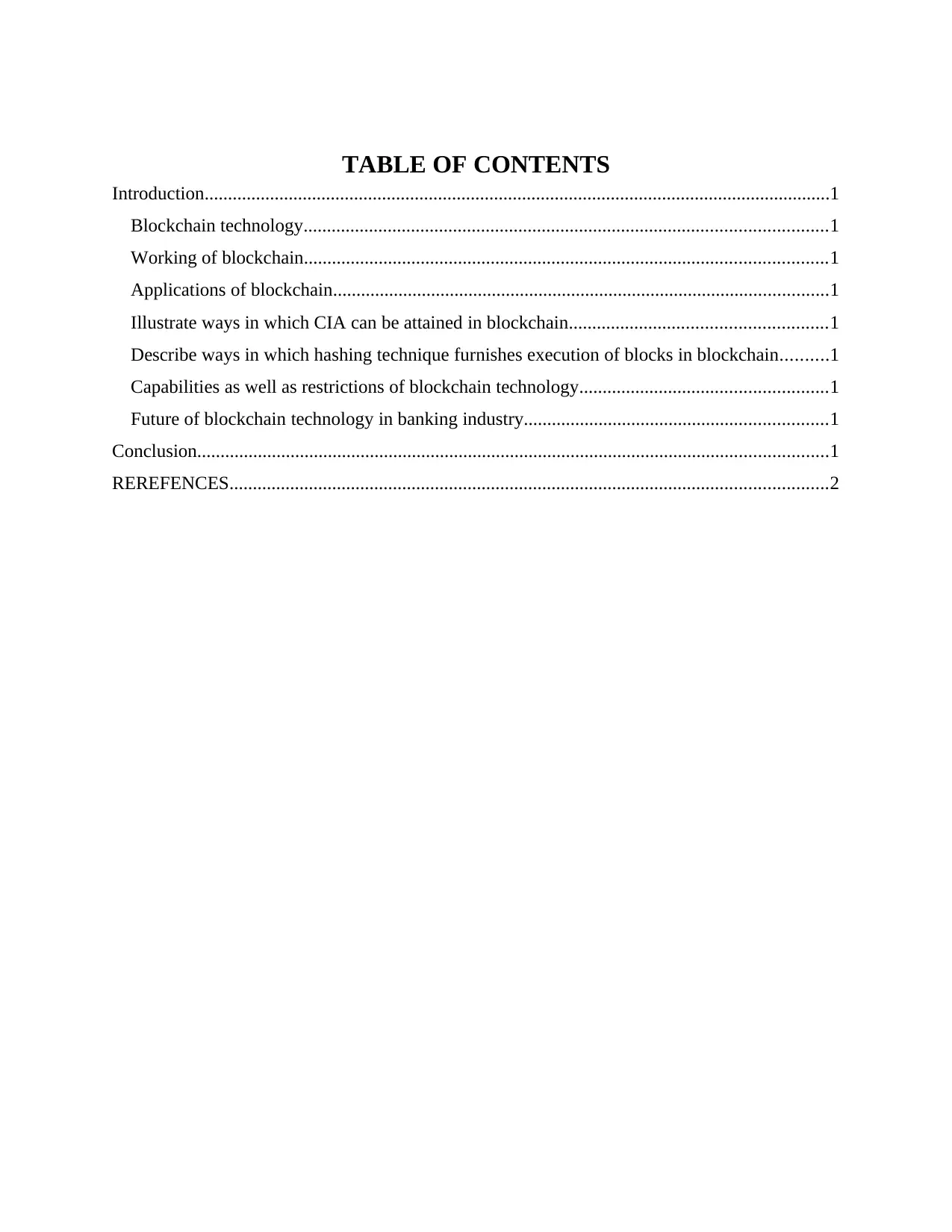
TABLE OF CONTENTS
Introduction......................................................................................................................................1
Blockchain technology................................................................................................................1
Working of blockchain................................................................................................................1
Applications of blockchain..........................................................................................................1
Illustrate ways in which CIA can be attained in blockchain.......................................................1
Describe ways in which hashing technique furnishes execution of blocks in blockchain..........1
Capabilities as well as restrictions of blockchain technology.....................................................1
Future of blockchain technology in banking industry.................................................................1
Conclusion.......................................................................................................................................1
REREFENCES................................................................................................................................2
Introduction......................................................................................................................................1
Blockchain technology................................................................................................................1
Working of blockchain................................................................................................................1
Applications of blockchain..........................................................................................................1
Illustrate ways in which CIA can be attained in blockchain.......................................................1
Describe ways in which hashing technique furnishes execution of blocks in blockchain..........1
Capabilities as well as restrictions of blockchain technology.....................................................1
Future of blockchain technology in banking industry.................................................................1
Conclusion.......................................................................................................................................1
REREFENCES................................................................................................................................2
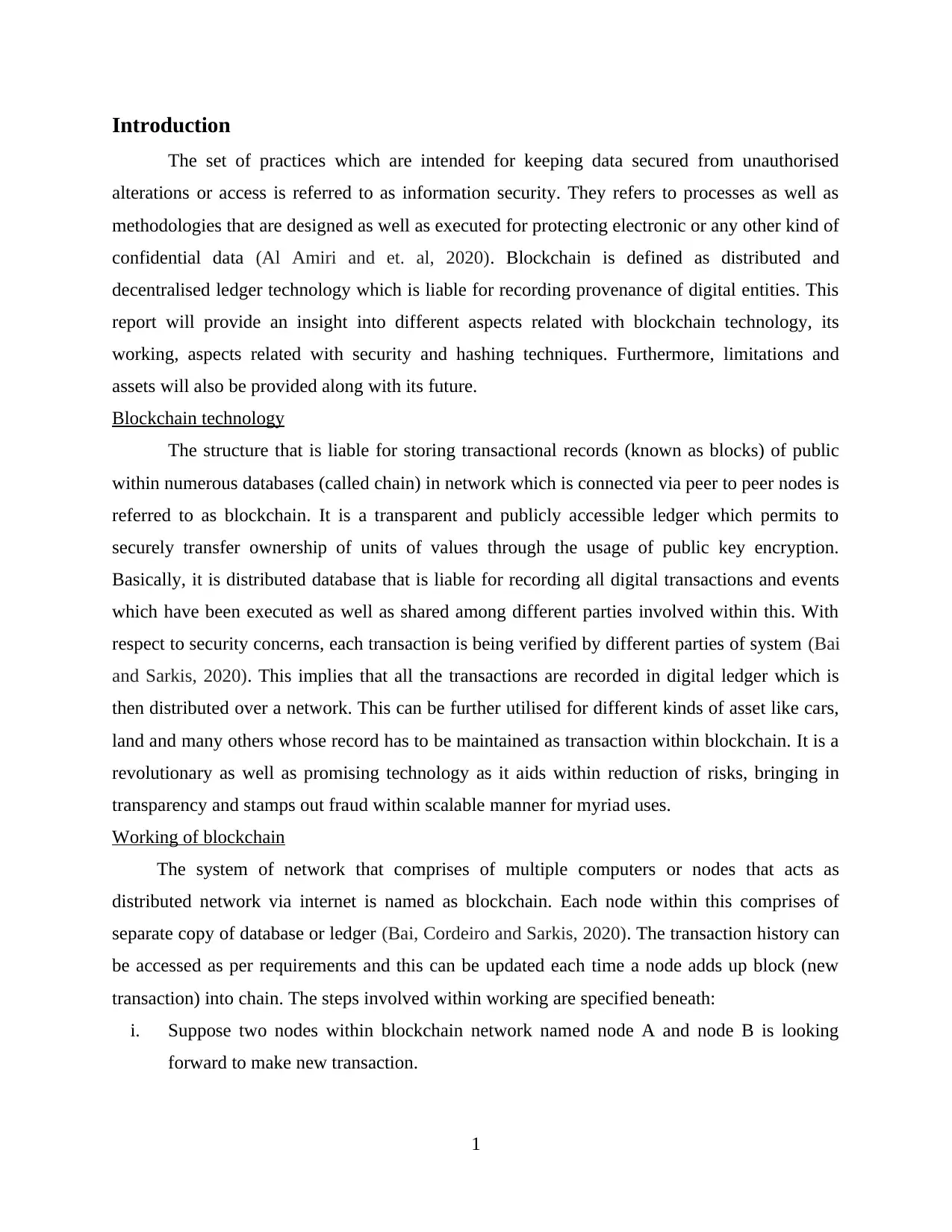
Introduction
The set of practices which are intended for keeping data secured from unauthorised
alterations or access is referred to as information security. They refers to processes as well as
methodologies that are designed as well as executed for protecting electronic or any other kind of
confidential data (Al Amiri and et. al, 2020). Blockchain is defined as distributed and
decentralised ledger technology which is liable for recording provenance of digital entities. This
report will provide an insight into different aspects related with blockchain technology, its
working, aspects related with security and hashing techniques. Furthermore, limitations and
assets will also be provided along with its future.
Blockchain technology
The structure that is liable for storing transactional records (known as blocks) of public
within numerous databases (called chain) in network which is connected via peer to peer nodes is
referred to as blockchain. It is a transparent and publicly accessible ledger which permits to
securely transfer ownership of units of values through the usage of public key encryption.
Basically, it is distributed database that is liable for recording all digital transactions and events
which have been executed as well as shared among different parties involved within this. With
respect to security concerns, each transaction is being verified by different parties of system (Bai
and Sarkis, 2020). This implies that all the transactions are recorded in digital ledger which is
then distributed over a network. This can be further utilised for different kinds of asset like cars,
land and many others whose record has to be maintained as transaction within blockchain. It is a
revolutionary as well as promising technology as it aids within reduction of risks, bringing in
transparency and stamps out fraud within scalable manner for myriad uses.
Working of blockchain
The system of network that comprises of multiple computers or nodes that acts as
distributed network via internet is named as blockchain. Each node within this comprises of
separate copy of database or ledger (Bai, Cordeiro and Sarkis, 2020). The transaction history can
be accessed as per requirements and this can be updated each time a node adds up block (new
transaction) into chain. The steps involved within working are specified beneath:
i. Suppose two nodes within blockchain network named node A and node B is looking
forward to make new transaction.
1
The set of practices which are intended for keeping data secured from unauthorised
alterations or access is referred to as information security. They refers to processes as well as
methodologies that are designed as well as executed for protecting electronic or any other kind of
confidential data (Al Amiri and et. al, 2020). Blockchain is defined as distributed and
decentralised ledger technology which is liable for recording provenance of digital entities. This
report will provide an insight into different aspects related with blockchain technology, its
working, aspects related with security and hashing techniques. Furthermore, limitations and
assets will also be provided along with its future.
Blockchain technology
The structure that is liable for storing transactional records (known as blocks) of public
within numerous databases (called chain) in network which is connected via peer to peer nodes is
referred to as blockchain. It is a transparent and publicly accessible ledger which permits to
securely transfer ownership of units of values through the usage of public key encryption.
Basically, it is distributed database that is liable for recording all digital transactions and events
which have been executed as well as shared among different parties involved within this. With
respect to security concerns, each transaction is being verified by different parties of system (Bai
and Sarkis, 2020). This implies that all the transactions are recorded in digital ledger which is
then distributed over a network. This can be further utilised for different kinds of asset like cars,
land and many others whose record has to be maintained as transaction within blockchain. It is a
revolutionary as well as promising technology as it aids within reduction of risks, bringing in
transparency and stamps out fraud within scalable manner for myriad uses.
Working of blockchain
The system of network that comprises of multiple computers or nodes that acts as
distributed network via internet is named as blockchain. Each node within this comprises of
separate copy of database or ledger (Bai, Cordeiro and Sarkis, 2020). The transaction history can
be accessed as per requirements and this can be updated each time a node adds up block (new
transaction) into chain. The steps involved within working are specified beneath:
i. Suppose two nodes within blockchain network named node A and node B is looking
forward to make new transaction.
1
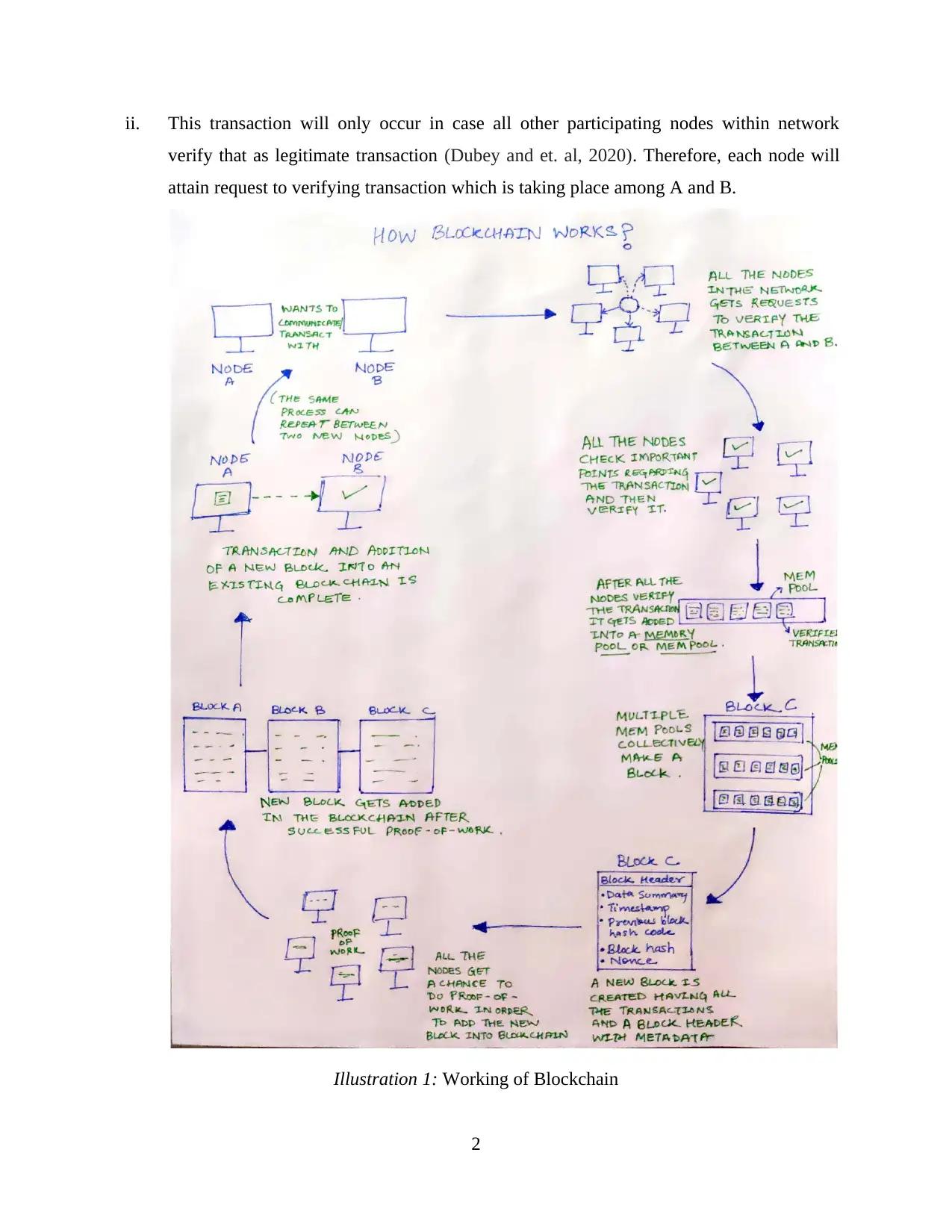
ii. This transaction will only occur in case all other participating nodes within network
verify that as legitimate transaction (Dubey and et. al, 2020). Therefore, each node will
attain request to verifying transaction which is taking place among A and B.
Illustration 1: Working of Blockchain
2
verify that as legitimate transaction (Dubey and et. al, 2020). Therefore, each node will
attain request to verifying transaction which is taking place among A and B.
Illustration 1: Working of Blockchain
2
Secure Best Marks with AI Grader
Need help grading? Try our AI Grader for instant feedback on your assignments.
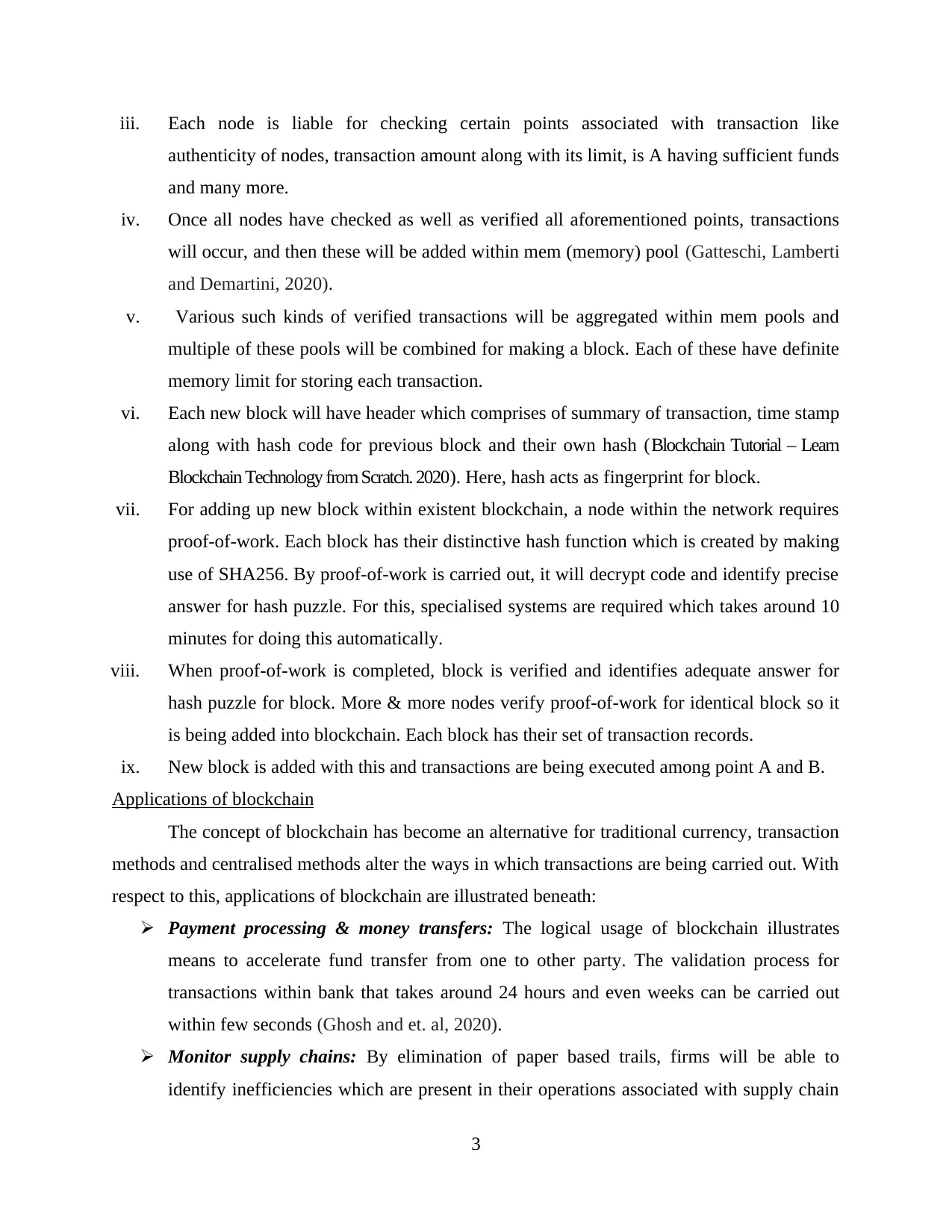
iii. Each node is liable for checking certain points associated with transaction like
authenticity of nodes, transaction amount along with its limit, is A having sufficient funds
and many more.
iv. Once all nodes have checked as well as verified all aforementioned points, transactions
will occur, and then these will be added within mem (memory) pool (Gatteschi, Lamberti
and Demartini, 2020).
v. Various such kinds of verified transactions will be aggregated within mem pools and
multiple of these pools will be combined for making a block. Each of these have definite
memory limit for storing each transaction.
vi. Each new block will have header which comprises of summary of transaction, time stamp
along with hash code for previous block and their own hash (Blockchain Tutorial – Learn
Blockchain Technology from Scratch. 2020). Here, hash acts as fingerprint for block.
vii. For adding up new block within existent blockchain, a node within the network requires
proof-of-work. Each block has their distinctive hash function which is created by making
use of SHA256. By proof-of-work is carried out, it will decrypt code and identify precise
answer for hash puzzle. For this, specialised systems are required which takes around 10
minutes for doing this automatically.
viii. When proof-of-work is completed, block is verified and identifies adequate answer for
hash puzzle for block. More & more nodes verify proof-of-work for identical block so it
is being added into blockchain. Each block has their set of transaction records.
ix. New block is added with this and transactions are being executed among point A and B.
Applications of blockchain
The concept of blockchain has become an alternative for traditional currency, transaction
methods and centralised methods alter the ways in which transactions are being carried out. With
respect to this, applications of blockchain are illustrated beneath:
Payment processing & money transfers: The logical usage of blockchain illustrates
means to accelerate fund transfer from one to other party. The validation process for
transactions within bank that takes around 24 hours and even weeks can be carried out
within few seconds (Ghosh and et. al, 2020).
Monitor supply chains: By elimination of paper based trails, firms will be able to
identify inefficiencies which are present in their operations associated with supply chain
3
authenticity of nodes, transaction amount along with its limit, is A having sufficient funds
and many more.
iv. Once all nodes have checked as well as verified all aforementioned points, transactions
will occur, and then these will be added within mem (memory) pool (Gatteschi, Lamberti
and Demartini, 2020).
v. Various such kinds of verified transactions will be aggregated within mem pools and
multiple of these pools will be combined for making a block. Each of these have definite
memory limit for storing each transaction.
vi. Each new block will have header which comprises of summary of transaction, time stamp
along with hash code for previous block and their own hash (Blockchain Tutorial – Learn
Blockchain Technology from Scratch. 2020). Here, hash acts as fingerprint for block.
vii. For adding up new block within existent blockchain, a node within the network requires
proof-of-work. Each block has their distinctive hash function which is created by making
use of SHA256. By proof-of-work is carried out, it will decrypt code and identify precise
answer for hash puzzle. For this, specialised systems are required which takes around 10
minutes for doing this automatically.
viii. When proof-of-work is completed, block is verified and identifies adequate answer for
hash puzzle for block. More & more nodes verify proof-of-work for identical block so it
is being added into blockchain. Each block has their set of transaction records.
ix. New block is added with this and transactions are being executed among point A and B.
Applications of blockchain
The concept of blockchain has become an alternative for traditional currency, transaction
methods and centralised methods alter the ways in which transactions are being carried out. With
respect to this, applications of blockchain are illustrated beneath:
Payment processing & money transfers: The logical usage of blockchain illustrates
means to accelerate fund transfer from one to other party. The validation process for
transactions within bank that takes around 24 hours and even weeks can be carried out
within few seconds (Ghosh and et. al, 2020).
Monitor supply chains: By elimination of paper based trails, firms will be able to
identify inefficiencies which are present in their operations associated with supply chain
3
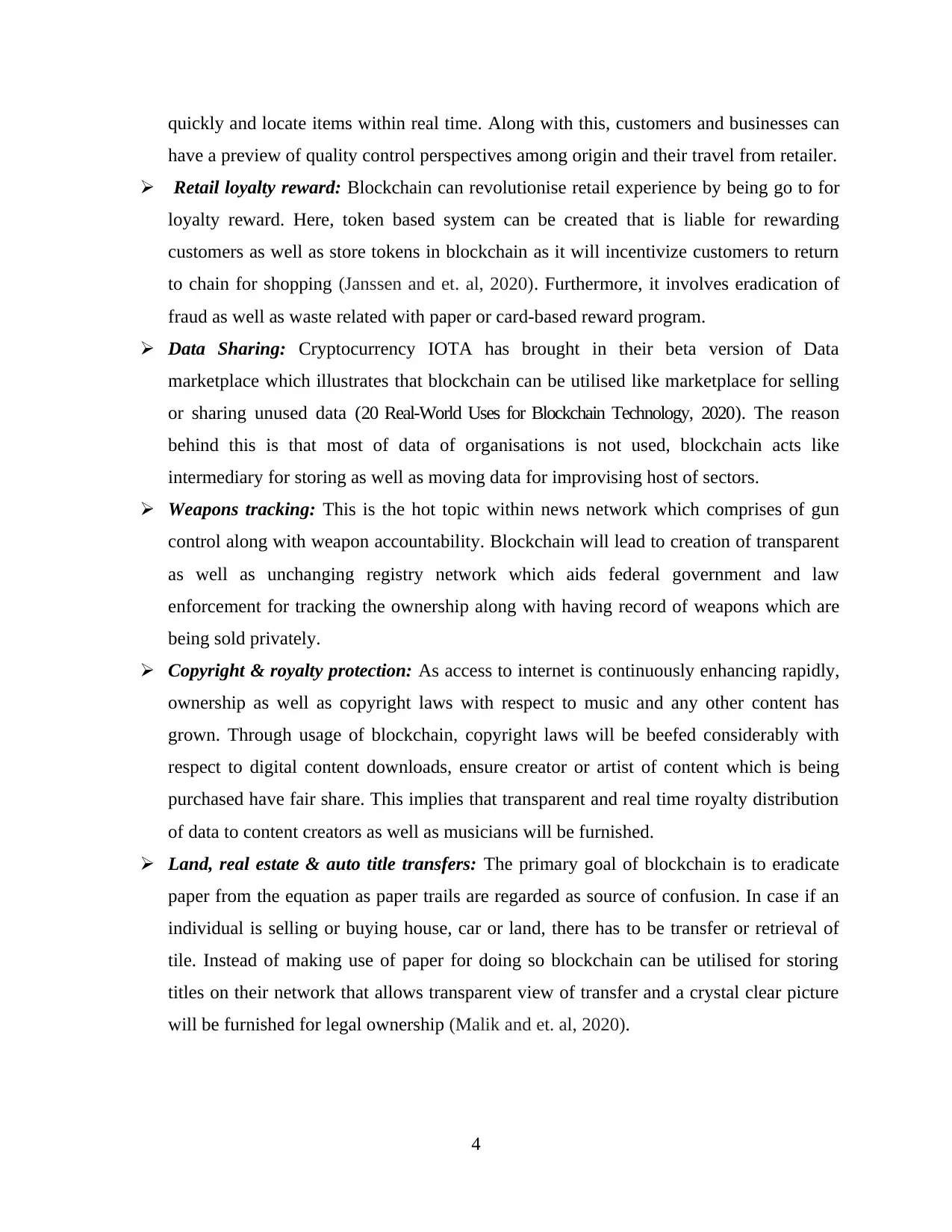
quickly and locate items within real time. Along with this, customers and businesses can
have a preview of quality control perspectives among origin and their travel from retailer.
Retail loyalty reward: Blockchain can revolutionise retail experience by being go to for
loyalty reward. Here, token based system can be created that is liable for rewarding
customers as well as store tokens in blockchain as it will incentivize customers to return
to chain for shopping (Janssen and et. al, 2020). Furthermore, it involves eradication of
fraud as well as waste related with paper or card-based reward program.
Data Sharing: Cryptocurrency IOTA has brought in their beta version of Data
marketplace which illustrates that blockchain can be utilised like marketplace for selling
or sharing unused data (20 Real-World Uses for Blockchain Technology, 2020). The reason
behind this is that most of data of organisations is not used, blockchain acts like
intermediary for storing as well as moving data for improvising host of sectors.
Weapons tracking: This is the hot topic within news network which comprises of gun
control along with weapon accountability. Blockchain will lead to creation of transparent
as well as unchanging registry network which aids federal government and law
enforcement for tracking the ownership along with having record of weapons which are
being sold privately.
Copyright & royalty protection: As access to internet is continuously enhancing rapidly,
ownership as well as copyright laws with respect to music and any other content has
grown. Through usage of blockchain, copyright laws will be beefed considerably with
respect to digital content downloads, ensure creator or artist of content which is being
purchased have fair share. This implies that transparent and real time royalty distribution
of data to content creators as well as musicians will be furnished.
Land, real estate & auto title transfers: The primary goal of blockchain is to eradicate
paper from the equation as paper trails are regarded as source of confusion. In case if an
individual is selling or buying house, car or land, there has to be transfer or retrieval of
tile. Instead of making use of paper for doing so blockchain can be utilised for storing
titles on their network that allows transparent view of transfer and a crystal clear picture
will be furnished for legal ownership (Malik and et. al, 2020).
4
have a preview of quality control perspectives among origin and their travel from retailer.
Retail loyalty reward: Blockchain can revolutionise retail experience by being go to for
loyalty reward. Here, token based system can be created that is liable for rewarding
customers as well as store tokens in blockchain as it will incentivize customers to return
to chain for shopping (Janssen and et. al, 2020). Furthermore, it involves eradication of
fraud as well as waste related with paper or card-based reward program.
Data Sharing: Cryptocurrency IOTA has brought in their beta version of Data
marketplace which illustrates that blockchain can be utilised like marketplace for selling
or sharing unused data (20 Real-World Uses for Blockchain Technology, 2020). The reason
behind this is that most of data of organisations is not used, blockchain acts like
intermediary for storing as well as moving data for improvising host of sectors.
Weapons tracking: This is the hot topic within news network which comprises of gun
control along with weapon accountability. Blockchain will lead to creation of transparent
as well as unchanging registry network which aids federal government and law
enforcement for tracking the ownership along with having record of weapons which are
being sold privately.
Copyright & royalty protection: As access to internet is continuously enhancing rapidly,
ownership as well as copyright laws with respect to music and any other content has
grown. Through usage of blockchain, copyright laws will be beefed considerably with
respect to digital content downloads, ensure creator or artist of content which is being
purchased have fair share. This implies that transparent and real time royalty distribution
of data to content creators as well as musicians will be furnished.
Land, real estate & auto title transfers: The primary goal of blockchain is to eradicate
paper from the equation as paper trails are regarded as source of confusion. In case if an
individual is selling or buying house, car or land, there has to be transfer or retrieval of
tile. Instead of making use of paper for doing so blockchain can be utilised for storing
titles on their network that allows transparent view of transfer and a crystal clear picture
will be furnished for legal ownership (Malik and et. al, 2020).
4

Illustrate ways in which CIA can be attained in blockchain
Blockchain is efficacious protocol that is behind Bitcoin and it has attained huge attention
in last some years. In context of system security, there are three aspects which have to be
considered, they are confidentiality, integrity as well as availability. When security of system is
regarded then these aspects need to be taken into consideration. There can be uncertainty within
integrity that often leads organisation to have issues associated with modification within
information, unauthorised access by intruder or third person and many others. In terms of
availability, it involves server crash, abrupt shutdown, etc (Warkentin and Orgeron, 2020). With
respect to confidentiality, this comprises of unauthenticated access to system by making use of
exploits or vulnerabilities present within. Blockchain aids within enhancement of security
aspects by making sure that all these three aspects CIA assist in minimisation of vulnerabilities
related with system.
Blockchain have a distributed database which is being shared as well as maintained via
different nodes that aids within attainment of CIA. In other words, Blockchain can be regarded
as from CIA (confidentiality, integrity and availability) security triad model. Transactions which
are being carried via blockchain are grouped as well as stored in distinct chain of blocks which
are linked with each other in a chronological order with hash. Each block comprises of hash of
previous block as well as its own hash, this provides a sequence of transactions which are being
made and each transaction is being verified by different nodes for ensuring CIA. This assist
within attaining all three security perspectives but confidentiality is not enforced strongly in
context of availability as well as integrity (Yavuz and Saiti, 2020). As blockchain is
decentralised system all the information is transparent to all individuals who share their data or
make any kind of transaction, due to this confidentiality cannot be enforced. Furthermore, as
blocks are associated with each other, it aids within retrieving all the required data. In addition to
this, integrity can be achieved within blockchain as data which resides in blocks cannot be
altered or modified. Various research are being carried for ensuring that confidentiality, integrity
as well as availability of information is being maintained simultaneously within the system.
Describe ways in which hashing technique furnishes execution of blocks in blockchain
Hashing with respect to blockchain refers to process associated with having input item of
different length that reflects item with fixed length (Yoon and Sheu, 2020). For an instance, with
reference cryptocurrencies transactions that are carried out are of different lengths and are
5
Blockchain is efficacious protocol that is behind Bitcoin and it has attained huge attention
in last some years. In context of system security, there are three aspects which have to be
considered, they are confidentiality, integrity as well as availability. When security of system is
regarded then these aspects need to be taken into consideration. There can be uncertainty within
integrity that often leads organisation to have issues associated with modification within
information, unauthorised access by intruder or third person and many others. In terms of
availability, it involves server crash, abrupt shutdown, etc (Warkentin and Orgeron, 2020). With
respect to confidentiality, this comprises of unauthenticated access to system by making use of
exploits or vulnerabilities present within. Blockchain aids within enhancement of security
aspects by making sure that all these three aspects CIA assist in minimisation of vulnerabilities
related with system.
Blockchain have a distributed database which is being shared as well as maintained via
different nodes that aids within attainment of CIA. In other words, Blockchain can be regarded
as from CIA (confidentiality, integrity and availability) security triad model. Transactions which
are being carried via blockchain are grouped as well as stored in distinct chain of blocks which
are linked with each other in a chronological order with hash. Each block comprises of hash of
previous block as well as its own hash, this provides a sequence of transactions which are being
made and each transaction is being verified by different nodes for ensuring CIA. This assist
within attaining all three security perspectives but confidentiality is not enforced strongly in
context of availability as well as integrity (Yavuz and Saiti, 2020). As blockchain is
decentralised system all the information is transparent to all individuals who share their data or
make any kind of transaction, due to this confidentiality cannot be enforced. Furthermore, as
blocks are associated with each other, it aids within retrieving all the required data. In addition to
this, integrity can be achieved within blockchain as data which resides in blocks cannot be
altered or modified. Various research are being carried for ensuring that confidentiality, integrity
as well as availability of information is being maintained simultaneously within the system.
Describe ways in which hashing technique furnishes execution of blocks in blockchain
Hashing with respect to blockchain refers to process associated with having input item of
different length that reflects item with fixed length (Yoon and Sheu, 2020). For an instance, with
reference cryptocurrencies transactions that are carried out are of different lengths and are
5
Paraphrase This Document
Need a fresh take? Get an instant paraphrase of this document with our AI Paraphraser

executed via hashing algorithm but the outcome taht is beingattained is of fixed length. This is
irrespective of length of input that has been given. The blockchain is linked list which comprises
of data as well as hash pointer which point towards previous block, thereby leads to creation of
chain. Hash pointer is alike to pointer but with reference to blockchain this not only comprises of
address of previous block long with this hash for data contained within previous block is also
used. Basically, this can be regarded as a reference point to what is contained within a previous
block and may also impact the next transaction (Ghosh and et. al, 2020). An instance can be
taken to acknowledge this aspect like account of individual is debitted with some account then
previous transaction details are needed as a reference to update the new amount. Similarly blocks
within blockchain chain makes use of hash function for this purpose.
Illustration 2: Hash Function in Blockchain
Blockchain do not remember entire input or output data, instead hash is being utilised for
tracking this. It aids within enhancement of security as well as minimisation of collision through
which availability and integrity can be maintained.
Capabilities as well as restrictions of blockchain technology
Blockchian are formulated like a decentralised database which functions like distributed
digital ledger. These ledgers are liable for recording as well as storing data within blocks (Al
Amiri and et. al, 2020). The capabilities along with limitations are specified beneath:
Capabilities:
6
irrespective of length of input that has been given. The blockchain is linked list which comprises
of data as well as hash pointer which point towards previous block, thereby leads to creation of
chain. Hash pointer is alike to pointer but with reference to blockchain this not only comprises of
address of previous block long with this hash for data contained within previous block is also
used. Basically, this can be regarded as a reference point to what is contained within a previous
block and may also impact the next transaction (Ghosh and et. al, 2020). An instance can be
taken to acknowledge this aspect like account of individual is debitted with some account then
previous transaction details are needed as a reference to update the new amount. Similarly blocks
within blockchain chain makes use of hash function for this purpose.
Illustration 2: Hash Function in Blockchain
Blockchain do not remember entire input or output data, instead hash is being utilised for
tracking this. It aids within enhancement of security as well as minimisation of collision through
which availability and integrity can be maintained.
Capabilities as well as restrictions of blockchain technology
Blockchian are formulated like a decentralised database which functions like distributed
digital ledger. These ledgers are liable for recording as well as storing data within blocks (Al
Amiri and et. al, 2020). The capabilities along with limitations are specified beneath:
Capabilities:
6
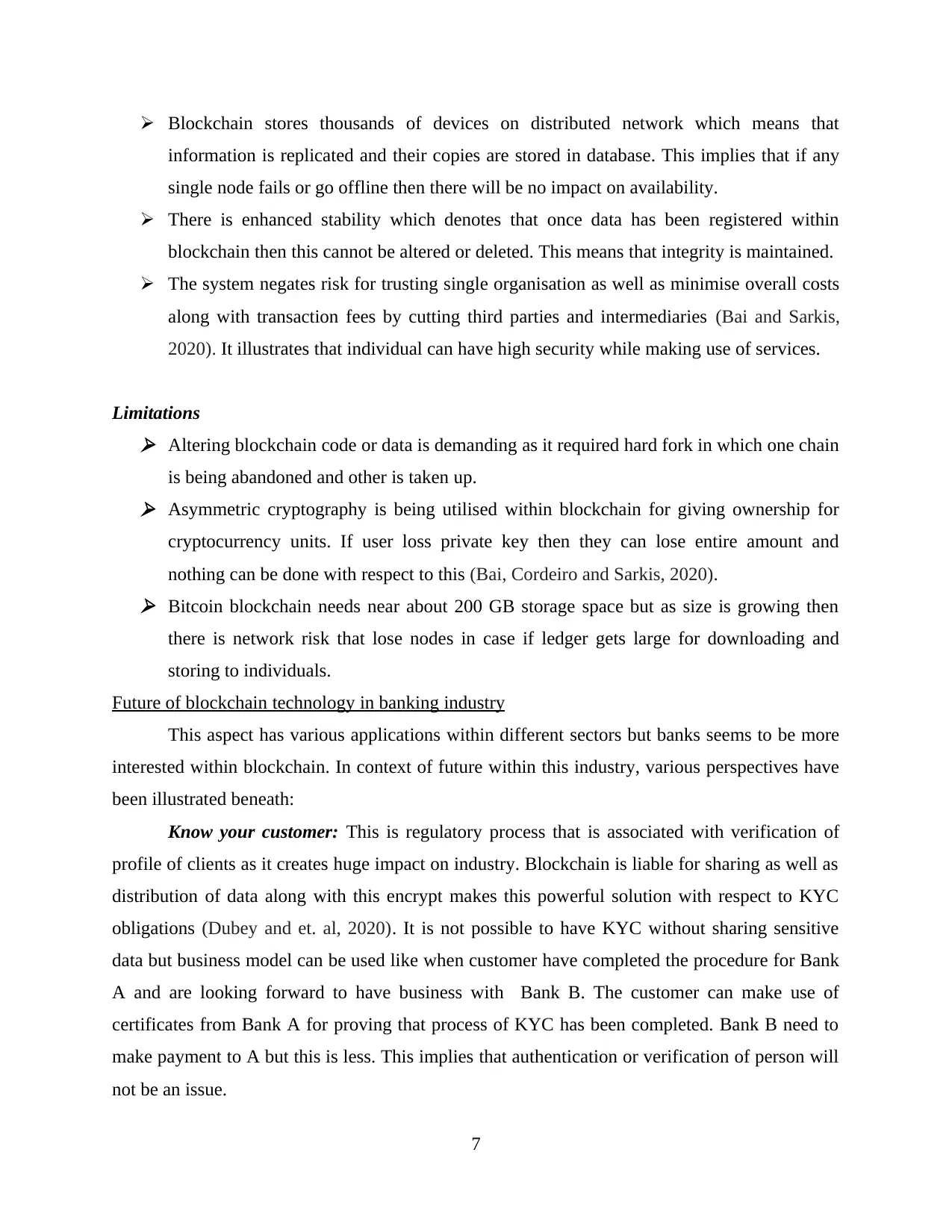
Blockchain stores thousands of devices on distributed network which means that
information is replicated and their copies are stored in database. This implies that if any
single node fails or go offline then there will be no impact on availability.
There is enhanced stability which denotes that once data has been registered within
blockchain then this cannot be altered or deleted. This means that integrity is maintained.
The system negates risk for trusting single organisation as well as minimise overall costs
along with transaction fees by cutting third parties and intermediaries (Bai and Sarkis,
2020). It illustrates that individual can have high security while making use of services.
Limitations Altering blockchain code or data is demanding as it required hard fork in which one chain
is being abandoned and other is taken up. Asymmetric cryptography is being utilised within blockchain for giving ownership for
cryptocurrency units. If user loss private key then they can lose entire amount and
nothing can be done with respect to this (Bai, Cordeiro and Sarkis, 2020). Bitcoin blockchain needs near about 200 GB storage space but as size is growing then
there is network risk that lose nodes in case if ledger gets large for downloading and
storing to individuals.
Future of blockchain technology in banking industry
This aspect has various applications within different sectors but banks seems to be more
interested within blockchain. In context of future within this industry, various perspectives have
been illustrated beneath:
Know your customer: This is regulatory process that is associated with verification of
profile of clients as it creates huge impact on industry. Blockchain is liable for sharing as well as
distribution of data along with this encrypt makes this powerful solution with respect to KYC
obligations (Dubey and et. al, 2020). It is not possible to have KYC without sharing sensitive
data but business model can be used like when customer have completed the procedure for Bank
A and are looking forward to have business with Bank B. The customer can make use of
certificates from Bank A for proving that process of KYC has been completed. Bank B need to
make payment to A but this is less. This implies that authentication or verification of person will
not be an issue.
7
information is replicated and their copies are stored in database. This implies that if any
single node fails or go offline then there will be no impact on availability.
There is enhanced stability which denotes that once data has been registered within
blockchain then this cannot be altered or deleted. This means that integrity is maintained.
The system negates risk for trusting single organisation as well as minimise overall costs
along with transaction fees by cutting third parties and intermediaries (Bai and Sarkis,
2020). It illustrates that individual can have high security while making use of services.
Limitations Altering blockchain code or data is demanding as it required hard fork in which one chain
is being abandoned and other is taken up. Asymmetric cryptography is being utilised within blockchain for giving ownership for
cryptocurrency units. If user loss private key then they can lose entire amount and
nothing can be done with respect to this (Bai, Cordeiro and Sarkis, 2020). Bitcoin blockchain needs near about 200 GB storage space but as size is growing then
there is network risk that lose nodes in case if ledger gets large for downloading and
storing to individuals.
Future of blockchain technology in banking industry
This aspect has various applications within different sectors but banks seems to be more
interested within blockchain. In context of future within this industry, various perspectives have
been illustrated beneath:
Know your customer: This is regulatory process that is associated with verification of
profile of clients as it creates huge impact on industry. Blockchain is liable for sharing as well as
distribution of data along with this encrypt makes this powerful solution with respect to KYC
obligations (Dubey and et. al, 2020). It is not possible to have KYC without sharing sensitive
data but business model can be used like when customer have completed the procedure for Bank
A and are looking forward to have business with Bank B. The customer can make use of
certificates from Bank A for proving that process of KYC has been completed. Bank B need to
make payment to A but this is less. This implies that authentication or verification of person will
not be an issue.
7
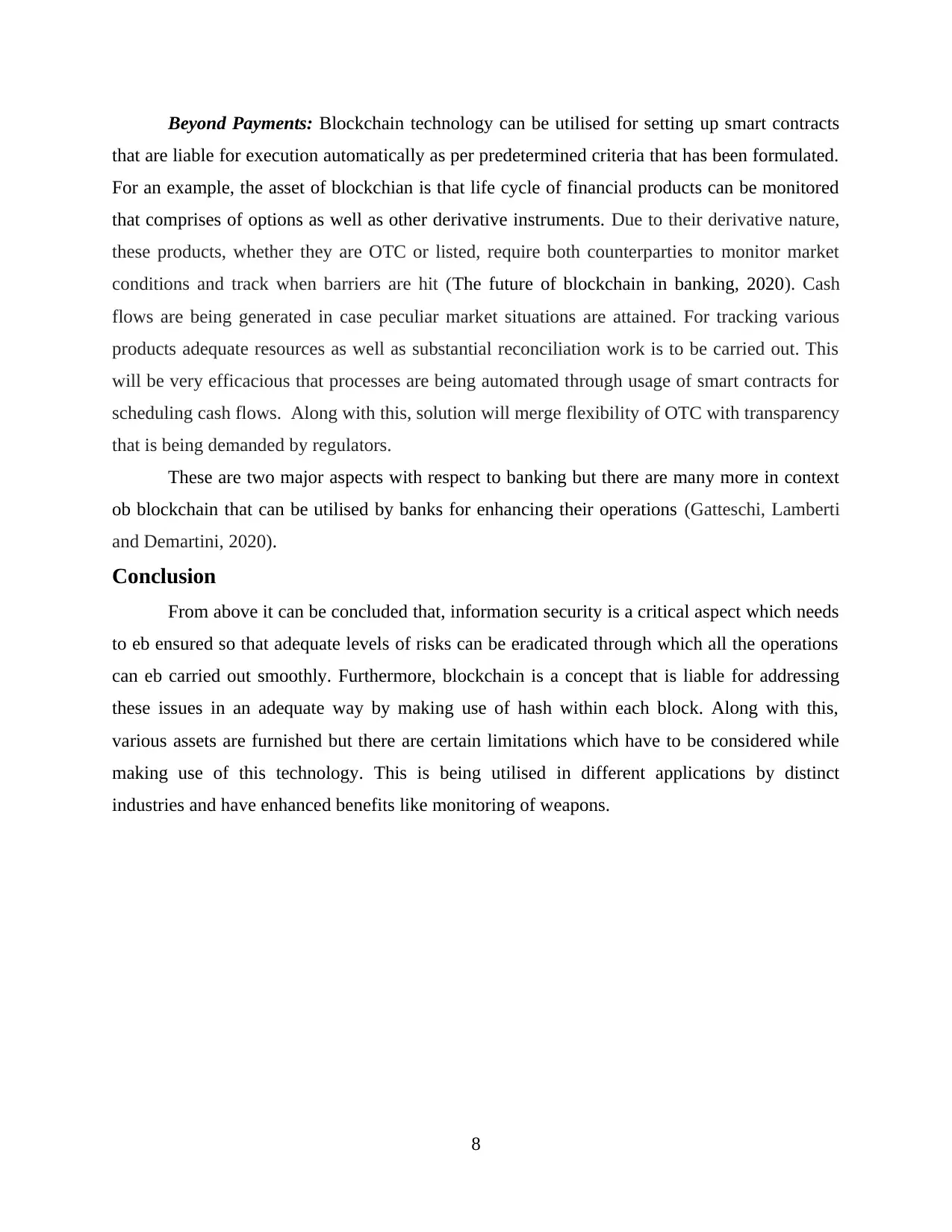
Beyond Payments: Blockchain technology can be utilised for setting up smart contracts
that are liable for execution automatically as per predetermined criteria that has been formulated.
For an example, the asset of blockchian is that life cycle of financial products can be monitored
that comprises of options as well as other derivative instruments. Due to their derivative nature,
these products, whether they are OTC or listed, require both counterparties to monitor market
conditions and track when barriers are hit (The future of blockchain in banking, 2020). Cash
flows are being generated in case peculiar market situations are attained. For tracking various
products adequate resources as well as substantial reconciliation work is to be carried out. This
will be very efficacious that processes are being automated through usage of smart contracts for
scheduling cash flows. Along with this, solution will merge flexibility of OTC with transparency
that is being demanded by regulators.
These are two major aspects with respect to banking but there are many more in context
ob blockchain that can be utilised by banks for enhancing their operations (Gatteschi, Lamberti
and Demartini, 2020).
Conclusion
From above it can be concluded that, information security is a critical aspect which needs
to eb ensured so that adequate levels of risks can be eradicated through which all the operations
can eb carried out smoothly. Furthermore, blockchain is a concept that is liable for addressing
these issues in an adequate way by making use of hash within each block. Along with this,
various assets are furnished but there are certain limitations which have to be considered while
making use of this technology. This is being utilised in different applications by distinct
industries and have enhanced benefits like monitoring of weapons.
8
that are liable for execution automatically as per predetermined criteria that has been formulated.
For an example, the asset of blockchian is that life cycle of financial products can be monitored
that comprises of options as well as other derivative instruments. Due to their derivative nature,
these products, whether they are OTC or listed, require both counterparties to monitor market
conditions and track when barriers are hit (The future of blockchain in banking, 2020). Cash
flows are being generated in case peculiar market situations are attained. For tracking various
products adequate resources as well as substantial reconciliation work is to be carried out. This
will be very efficacious that processes are being automated through usage of smart contracts for
scheduling cash flows. Along with this, solution will merge flexibility of OTC with transparency
that is being demanded by regulators.
These are two major aspects with respect to banking but there are many more in context
ob blockchain that can be utilised by banks for enhancing their operations (Gatteschi, Lamberti
and Demartini, 2020).
Conclusion
From above it can be concluded that, information security is a critical aspect which needs
to eb ensured so that adequate levels of risks can be eradicated through which all the operations
can eb carried out smoothly. Furthermore, blockchain is a concept that is liable for addressing
these issues in an adequate way by making use of hash within each block. Along with this,
various assets are furnished but there are certain limitations which have to be considered while
making use of this technology. This is being utilised in different applications by distinct
industries and have enhanced benefits like monitoring of weapons.
8
Secure Best Marks with AI Grader
Need help grading? Try our AI Grader for instant feedback on your assignments.
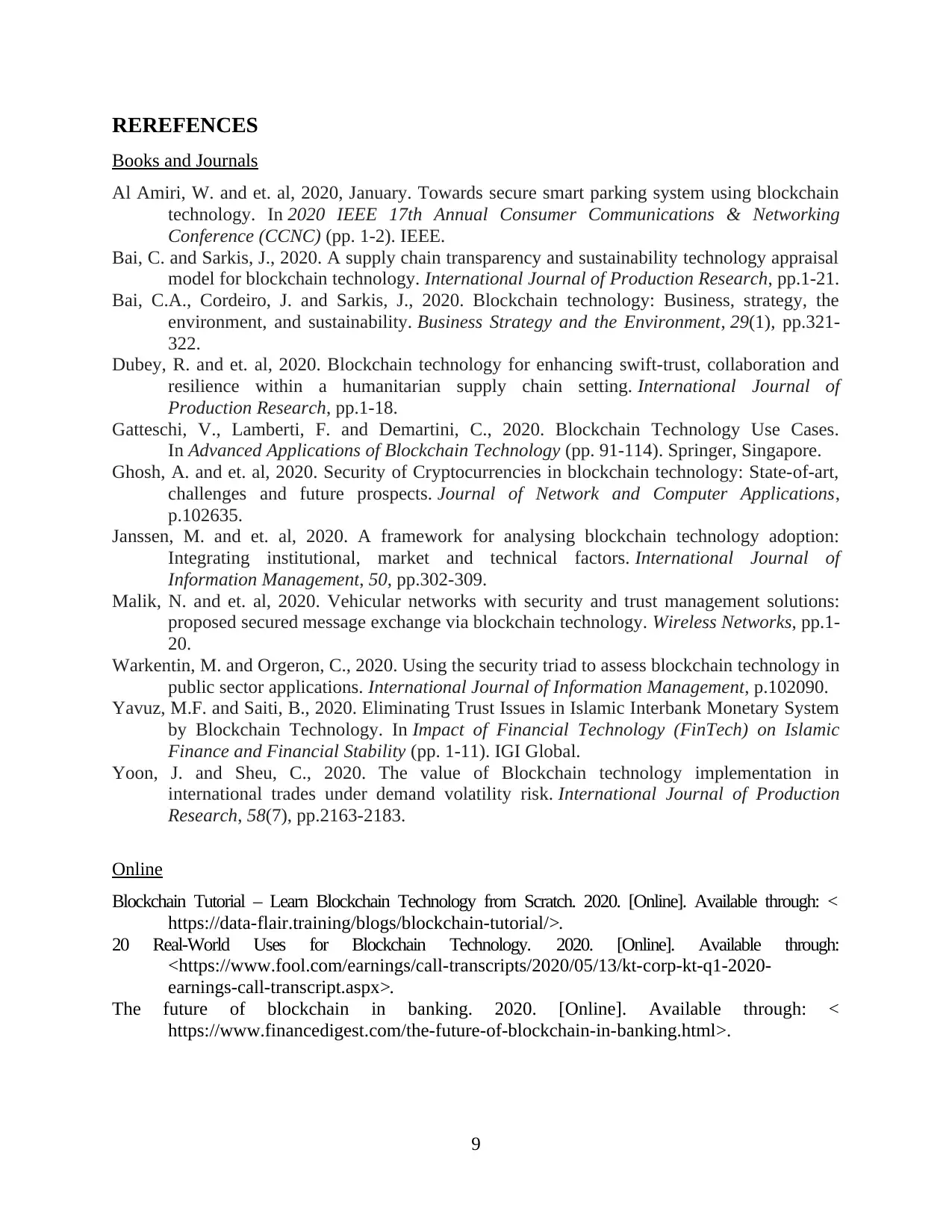
REREFENCES
Books and Journals
Al Amiri, W. and et. al, 2020, January. Towards secure smart parking system using blockchain
technology. In 2020 IEEE 17th Annual Consumer Communications & Networking
Conference (CCNC) (pp. 1-2). IEEE.
Bai, C. and Sarkis, J., 2020. A supply chain transparency and sustainability technology appraisal
model for blockchain technology. International Journal of Production Research, pp.1-21.
Bai, C.A., Cordeiro, J. and Sarkis, J., 2020. Blockchain technology: Business, strategy, the
environment, and sustainability. Business Strategy and the Environment, 29(1), pp.321-
322.
Dubey, R. and et. al, 2020. Blockchain technology for enhancing swift-trust, collaboration and
resilience within a humanitarian supply chain setting. International Journal of
Production Research, pp.1-18.
Gatteschi, V., Lamberti, F. and Demartini, C., 2020. Blockchain Technology Use Cases.
In Advanced Applications of Blockchain Technology (pp. 91-114). Springer, Singapore.
Ghosh, A. and et. al, 2020. Security of Cryptocurrencies in blockchain technology: State-of-art,
challenges and future prospects. Journal of Network and Computer Applications,
p.102635.
Janssen, M. and et. al, 2020. A framework for analysing blockchain technology adoption:
Integrating institutional, market and technical factors. International Journal of
Information Management, 50, pp.302-309.
Malik, N. and et. al, 2020. Vehicular networks with security and trust management solutions:
proposed secured message exchange via blockchain technology. Wireless Networks, pp.1-
20.
Warkentin, M. and Orgeron, C., 2020. Using the security triad to assess blockchain technology in
public sector applications. International Journal of Information Management, p.102090.
Yavuz, M.F. and Saiti, B., 2020. Eliminating Trust Issues in Islamic Interbank Monetary System
by Blockchain Technology. In Impact of Financial Technology (FinTech) on Islamic
Finance and Financial Stability (pp. 1-11). IGI Global.
Yoon, J. and Sheu, C., 2020. The value of Blockchain technology implementation in
international trades under demand volatility risk. International Journal of Production
Research, 58(7), pp.2163-2183.
Online
Blockchain Tutorial – Learn Blockchain Technology from Scratch. 2020. [Online]. Available through: <
https://data-flair.training/blogs/blockchain-tutorial/>.
20 Real-World Uses for Blockchain Technology. 2020. [Online]. Available through:
<https://www.fool.com/earnings/call-transcripts/2020/05/13/kt-corp-kt-q1-2020-
earnings-call-transcript.aspx>.
The future of blockchain in banking. 2020. [Online]. Available through: <
https://www.financedigest.com/the-future-of-blockchain-in-banking.html>.
9
Books and Journals
Al Amiri, W. and et. al, 2020, January. Towards secure smart parking system using blockchain
technology. In 2020 IEEE 17th Annual Consumer Communications & Networking
Conference (CCNC) (pp. 1-2). IEEE.
Bai, C. and Sarkis, J., 2020. A supply chain transparency and sustainability technology appraisal
model for blockchain technology. International Journal of Production Research, pp.1-21.
Bai, C.A., Cordeiro, J. and Sarkis, J., 2020. Blockchain technology: Business, strategy, the
environment, and sustainability. Business Strategy and the Environment, 29(1), pp.321-
322.
Dubey, R. and et. al, 2020. Blockchain technology for enhancing swift-trust, collaboration and
resilience within a humanitarian supply chain setting. International Journal of
Production Research, pp.1-18.
Gatteschi, V., Lamberti, F. and Demartini, C., 2020. Blockchain Technology Use Cases.
In Advanced Applications of Blockchain Technology (pp. 91-114). Springer, Singapore.
Ghosh, A. and et. al, 2020. Security of Cryptocurrencies in blockchain technology: State-of-art,
challenges and future prospects. Journal of Network and Computer Applications,
p.102635.
Janssen, M. and et. al, 2020. A framework for analysing blockchain technology adoption:
Integrating institutional, market and technical factors. International Journal of
Information Management, 50, pp.302-309.
Malik, N. and et. al, 2020. Vehicular networks with security and trust management solutions:
proposed secured message exchange via blockchain technology. Wireless Networks, pp.1-
20.
Warkentin, M. and Orgeron, C., 2020. Using the security triad to assess blockchain technology in
public sector applications. International Journal of Information Management, p.102090.
Yavuz, M.F. and Saiti, B., 2020. Eliminating Trust Issues in Islamic Interbank Monetary System
by Blockchain Technology. In Impact of Financial Technology (FinTech) on Islamic
Finance and Financial Stability (pp. 1-11). IGI Global.
Yoon, J. and Sheu, C., 2020. The value of Blockchain technology implementation in
international trades under demand volatility risk. International Journal of Production
Research, 58(7), pp.2163-2183.
Online
Blockchain Tutorial – Learn Blockchain Technology from Scratch. 2020. [Online]. Available through: <
https://data-flair.training/blogs/blockchain-tutorial/>.
20 Real-World Uses for Blockchain Technology. 2020. [Online]. Available through:
<https://www.fool.com/earnings/call-transcripts/2020/05/13/kt-corp-kt-q1-2020-
earnings-call-transcript.aspx>.
The future of blockchain in banking. 2020. [Online]. Available through: <
https://www.financedigest.com/the-future-of-blockchain-in-banking.html>.
9
1 out of 11
Related Documents
Your All-in-One AI-Powered Toolkit for Academic Success.
+13062052269
info@desklib.com
Available 24*7 on WhatsApp / Email
![[object Object]](/_next/static/media/star-bottom.7253800d.svg)
Unlock your academic potential
© 2024 | Zucol Services PVT LTD | All rights reserved.




